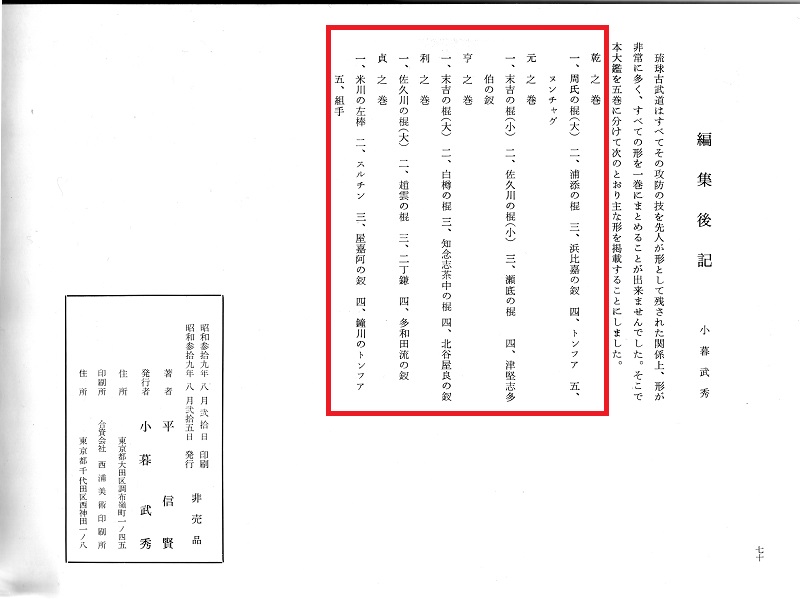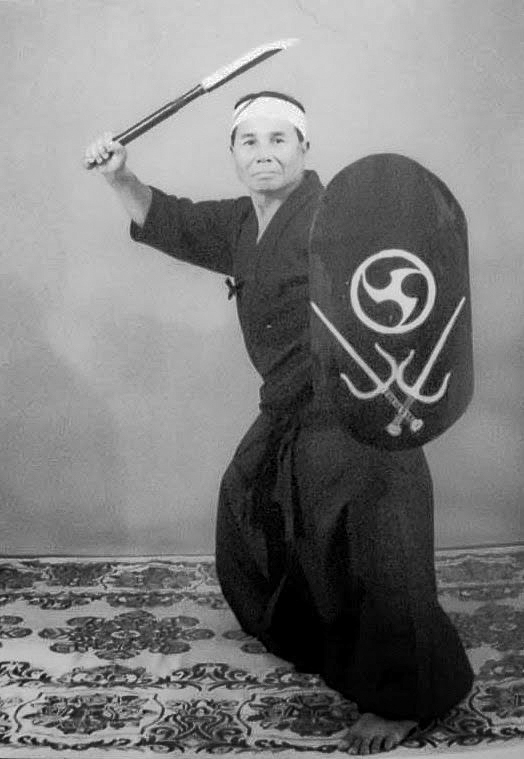Yesterday, David Hansen of Isshin-ryū posted a good question on Facebook. It is as follows.
This photo shows Shinken Sensei to be holding more of a machete than short spear. What year did this lineage change to short spear and flipping rochin back n forth?
FB Post
As noted in the post, today’s techniques of the tinbē included a lot of flipping back and forth of the short spear (rōchin), which has a long handle and a short metal tip. But a short halberd such as in the photo can’t be flipped back and forth because you would cut yourself. Therefore, it is a very good question. This is because the short halberd used in this staged photo cannot be used for the kata.
To get closer to an answer, I first wondered where the photo was taken. Taira seems to wear an Iaidō uniform, and the short spear shows a considerable amount of craftmanship, something not seen on Okinawa at the time. I have neither seen the photo nor these particular weapons in the Shimbukan dojo in Okinawa in over a year. On the other side, it is known that the photo is part of a whole series, which is found in the enlarged edition of Taira’s Ryūkyū Kobudō Taikan (1997), published under supervision of Inoue Kishō. Therefore, I would guess that the photo was taken in Japan.
Moreover, no-one knows when Taira created the “Tinbē kata.” Maybe in the 60s? Maybe after this photo was taken?
Well, let’s see what there is.
In 1964, the original edition of Taira Shinken’s Ryūkyū Kobudō Taikan (Encyclopedia of Ancient Ryūkyūan Martial Arts with Weaponry) was published. It was the first ever attempt to publish a monograph solely concerned with Ryūkyū Kobudō. The term Ryūkyū Kobudō does not refer to all schools of ancient Ryūkyūan martial arts with weaponry. Rather, it decidedly refers to the syllabus researched and established by Taira Shinken.
In one of two editions I own, a correction sheet is found glued in. In the other edition it is not, neither are there signs of glue. Obviously, and while this publication was already limited to comparatively few printed copies anyway, this correction sheet was not included in all of the copies, or it got lost.
According to the postscript by the publisher Kogure Takehide, it wasn’t possible to collect all kata of Taira Shinken in this one single volume. Therefore, the Ryūkyū Kobudō Taikan was actually planned as a series of five volumes, each with a individual volume name:
- 1) Kan no maki.
- 2) Gen no maki.
- 3) Kō no maki.
- 4) Ri no maki.
- 5) Tei no maki.
However, only the first of these volumes was ever published.

The remaining four volumes – and their unpublished photos and texts – never saw the light of day. However, on page 70 of the original Vol. 1, the publisher Kogure Takehide provided a list of kata that were planned to be published in all five volumes.
There is no Tinbē kata mentioned in it. However, Volume 5 had the following kata list.
Vol. 5 – Tei no maki
- Yonegawa no Hidari-bō
- Suruchin
- Yakā no Sai
- Kanegawa no Tonfā
- Kumite
Kanegawa no Tonfā is an intriguing name. No kata under this name exists, so it might have been a mistake. For comparison, I looked at the entry for Nichōgama, which is found in Volume 4, and it is simply referred to as Nichōgama, not as Kanegawa no Nichōgama, as it is called today.
Then, Kanegawa no Tonfā could be a mistake, and actually refer to Kanegawa no Tinbē.
However, Taira Shinken invented a lot of kata after 1945. Therefore, couldn’t it be that he planned a Kanegawa no Tonfā, and then discarded it, and created Kanegawa no Tinbē instead?
The following shows how chaotic Taira sometimes worked. In 1938, Taira created Kongō no Kon based on Shūshi no Kon, but later discarded the changes, and created a completely new Kongō no Kon instead. The following instance is an example of how unclear these traditions are in reality: In an interview in 1997, when Akamine Eisuke was asked when the Shō and Dai versions of Shūshi no Kon were developed, he replied, “I guess it was after the war.” So, nothing is clear, and nobody seems to know the details of Taira’s creations. So, in creating kata, Taira did a lot of trial and error and changes and developments over time.
If Kanegawa no Tonfā was a mistake, and actually Kanegawa no Tinbē was planned to be included in Vol. 5 of the Ryūkyū Kobudō Taikan, this would be the earliest date of it being mentioned. 1964. So it could have been created around that time, or earlier.
What do the Okinawans say? Does anyone even know the details?
The simple question remains: When was Kanegawa no Tinbē created?
© 2023, Andreas Quast. All rights reserved.

